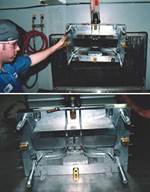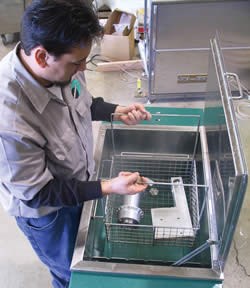How to Boost Lean Manufacturing with Ultrasonic Mold Cleaning
With its considerable cost savings and reduction in personnel and time, ultrasonic cleaning is a natural corollary to lean manufacturing for the moldmaking industry.
In terms of parts cleaning, the most efficient answer for lean manufacturing is the use of ultrasonic tanks. With ultrasonic cleaning, parts to be cleaned are placed in a chamber or tank containing an environmentally-friendly, water-based cleaning soap.
No wasted motion. No wasted material. No wasted space. No excessive inventory. All of this adds up to the extremely efficient set of processes known as lean manufacturing. Into this environment now comes a methodology for cleaning molds that eliminates the wasted time, personnel and motion previously associated with that activity, and clearly meets the rugged standards of lean manufacturing: ultrasonic cleaning.
Through heavy use, molds become contaminated with grease, hydraulic oil, rust, grime, carbon, aluminum shavings and material gassing, and many are still cleaned the old-fashioned way with labor-intensive hand scrubbing and solvents. Using such methods, not only is time and manpower wasted, but the cleaning itself is often hit-or-miss.
Having observed hand methods to be uneconomical within their operations, some companies outsource mold cleaning. This method has its drawbacks as well—not the least of which is that parts must normally be accumulated for a bulk discount before sending out. This adds considerable waste in terms of time, space and the necessity for large inventory.
The most efficient answer for lean manufacturing is the use of ultrasonic tanks. With ultrasonic cleaning, molds to be cleaned are placed in a chamber or tank containing an environmentally friendly, water-based cleaning soap. An energy-converting transducer is then electronically activated to produce sonic frequencies approaching 40,000 cycles per second.
Cleaning is accomplished as energy is released by the creation and collapse (called cavitation) of microscopic bubbles formed at these ultrasonic frequencies. The resultant shock waves break up and lift off dirt, residues and other contaminants.
For lean manufacturing, this means many benefits. Labor is substantially reduced both in hours and number of personnel, and the parts are actually and thoroughly washed. Ultrasonics also does away with the need to stock up quantities of parts before shipping them for cleaning.
Related Content
-
How to Improve Your Current Efficiency Rate
An alternative approach to taking on more EDM-intensive work when technology and personnel investment is not an option.
-
Steps for Determining Better Mold Prices
Improving your mold pricing requires a deeper understanding of your business.
-
MMT Chats: Marketing’s Impact on Mold Manufacturing
Kelly Kasner, Director of Sales and Marketing for Michiana Global Mold (MGM) talks about the benefits her marketing and advertising, MGM’s China partnership and the next-generation skills gap. This episode is brought to you by ISCAR with New Ideas for Machining Intelligently.











_300x250 3.png;maxWidth=300;quality=90)





